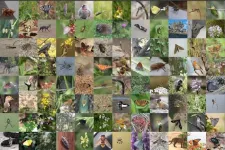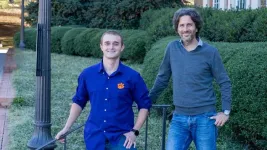(Press-News.org) Highlights:
Human actions influence the success and how species spread throughout geographic locations.
This is why monitoring wildlife biodiversity is critical for scientists and policymakers to understand and preserve the present state of flora and fauna.
A study led by University of Florida scientists published today in the journal of Trends and Ecology and Evolution advocates for change to promote standardized practices in the field – a practice that has been missing from the science.
Assessing wildlife populations, as well as understanding the dynamics of their numbers and distributions across various regions, is a critical measure known in science as abundance.
“This task presents significant challenges due to the multifaceted nature of biodiversity, coupled with the variety of methods used in studies, each yielding varied outcomes for distinct objectives,” said Corey Callaghan, assistant professor of global ecology at UF/IFAS Fort Lauderdale Research and Education Center. “This diversity in approach has led to a lack of standardized practices within the field.”
A study led by University of Florida scientists at the Institute of Food and Agricultural Sciences (UF/IFAS) published today in the journal of Trends and Ecology and Evolution probes the nuances of biodiversity monitoring, advocating for changes that promote a standardized approach.
At the heart of the paper is a comparison of two metrics scientists use to monitor biodiversity – relative and absolute abundance. The authors shed light on their fundamental distinctions and indicate their advantages and disadvantages, but ultimately advocate for absolute abundance to arrive at direct information about species population sizes.
Absolute abundance means counting all the animals in an area with the intention of acquiring an exact total. Meanwhile, relative abundance arrives at an estimate of how many animals there are compared to each other or compared to a certain standard. Both methods have their own ways of collecting data.
“The insights from this paper aim to promote a more nuanced and informed approach to biodiversity monitoring, influencing both scientific research and conservation policy,” he said. “We hope to engage a wide audience, including ecologists, conservationists, policymakers, and citizen scientists, highlighting the importance of methodological choices in biodiversity monitoring.”
Absolute abundance will arrive at a more precise number and is harder to collect because it will involve counting or figuring out how many animals are in a unit of space. This method will generally have some errors in measurements with a degree of uncertainty, depending on species traits.
Relative abundance is usually less complicated and doesn't arrive at an exact number but helps see trends or differences between areas or times. This simplicity makes it attractive in that it allows for the assistance of citizen scientists to help collect data.
“Both are important for understanding and protecting biodiversity,” said Callaghan. “The goal is to encourage the adoption of methodologies that best capture the true state of biodiversity, enabling more effective conservation actions and policy decisions.”
Understanding the quantity of organisms and how they're changing over time is crucial. Different methods for counting species have been debated, but using absolute abundance -- the actual number of individuals -- often gives the most accurate picture, according to the study’s authors.
“It provides a sense of the real size of a population, which is important for conservation efforts,” he said. “Overall, absolute abundance is crucial for understanding the real numbers of species, but it's important to use the right methods and scales to interpret the data accurately.”
For the scientific and citizen science communities, the authors hope to spark a dialogue on the necessity of integrating both relative and absolute abundance measurements into biodiversity monitoring practices.
“We envision a collaborative effort to refine data collection and analysis methods, making them more accessible and actionable for conservation purposes,” he said. “This includes encouraging the development and sharing of best practices that can accommodate the complexities of different ecosystems and species.”
END
Monitoring and measuring biodiversity require more than just numbers; scientists advocate for change
2024-03-19
ELSE PRESS RELEASES FROM THIS DATE:
Sugary drinks, fruit juices linked to higher risk of developing Type 2 diabetes among boys
2024-03-19
Research Highlights:
Preliminary findings from a long-term study of children in Massachusetts have potentially linked regularly drinking sugary drinks and fruit juices (8 ounces or more daily) during childhood and adolescence to a higher risk of developing Type 2 diabetes, based on glycemic markers, among boys but not girls.
The researchers also found that eating fresh fruit in childhood and adolescence was not associated with an increase or reduction in markers for Type 2 diabetes risk.
Embargoed until 3p.m. CT/4 p.m. ET, Tuesday, March ...
Heat exposure may increase inflammation and impair the immune system
2024-03-19
Research Highlights:
Exposure to high heat may impair the cells of the immune system that remember specific viruses and germs and over-produce signaling molecules that can lead to inflammation.
Previous research testing participants’ blood on hot summer days largely only examined the effects of air temperature; they have not included analysis of the levels of immune-signaling molecules and markers of inflammation.
Embargoed until 3 p.m. CT/4 p.m. ET, Tuesday, March 19, 2024
CHICAGO, March 19, 2024 — Short-term exposure to higher heat may increase ...
Rapid specific detection of oral pathogens using CRISPR-based diagnostics
2024-03-19
Alexandria, VA, USA – A study aiming to develop a low-cost, rapid detection technique for the widescale detection and screening of oral microorganisms suitable for point-of-care settings was presented at the 102nd General Session of the IADR, which was held in conjunction with the 53rd Annual Meeting of the American Association for Dental, Oral, and Craniofacial Research and the 48th Annual Meeting of the Canadian Association for Dental Research, on March 13-16, 2024, in New Orleans, LA, USA.
The abstract, ...
Polyphenol-mediated oxygenating hydrogel ameliorates periodontitis by targeting stem cell senescence
2024-03-19
Alexandria, VA, USA – A study aiming to develop a novel therapeutic strategy for periodontitis that targeted stem cell senescence by modulating the microenvironmental cues was presented at the 102nd General Session of the IADR, which was held in conjunction with the 53rd Annual Meeting of the American Association for Dental, Oral, and Craniofacial Research and the 48th Annual Meeting of the Canadian Association for Dental Research, on March 13-16, 2024, in New Orleans, LA, USA.
The abstract, “Polyphenol-Mediated Oxygenating Hydrogel Ameliorates Periodontitis By Targeting Stem Cell Senescence” was presented during the “Biologically ...
Sexual harassment goes unchecked in many sub-Saharan African newsrooms
2024-03-19
As much as 58% of sexual harassment reports lead to no action in sub-Saharan African newsrooms, study finds.
Sexual harassment often goes unchecked in sub-Saharan African newsrooms despite many employers having policies in place, according to a study conducted by City, University of London and the University of Maryland's Philip Merrill College of Journalism.
Researchers Dr Lindsey Blumell (City) and Dinfin Mulupi (Maryland) surveyed nearly 600 news professionals and analysed 17 anti-sexual harassment policies in newsrooms across eight sub-Saharan African countries between July and October 2020.
The study sampled data from Botswana, Kenya, Malawi, ...
Clemson astrophysicist’s research could provide a hint in the search for dark matter
2024-03-19
Dark matter is one of science’s greatest mysteries.
It doesn’t absorb, reflect or emit light, so we can’t see it. But its presence is implied by the gravitational effects it appears to have on galaxies.
Although dark matter makes up about 85 percent of the cosmos, scientists know very little about its fundamental nature.
Theories abound, and research by Clemson University postdoctoral fellow Alex McDaniel provides some of the most stringent constraints on the nature of dark matter yet.
His research also reveals a small hint of a signal that, if real, ...
A sneak-peak of the updated human salivary proteome wiki
2024-03-19
Alexandria, VA, USA – A Hands-on Workshop introducing the Updated Human Salivary Proteome (HSP) Wiki was presented at the 102nd General Session of the IADR, which was held in conjunction with the 53rd Annual Meeting of the American Association for Dental, Oral, and Craniofacial Research and the 48th Annual Meeting of the Canadian Association for Dental Research, on March 13-16, 2024, in New Orleans, LA, USA.
The information accumulated in the literature about salivary proteins, their expression, function, and role in health and disease has been made available by establishing the Human ...
Evaluating homelessness empathy through virtual reality among dental students
2024-03-19
Alexandria, VA, USA – A study aiming to determine experiential impact on student-empathy in relation to timing of when they experienced a VR-simulation of homelessness was presented at the 102nd General Session of the IADR, which was held in conjunction with the 53rd Annual Meeting of the American Association for Dental, Oral, and Craniofacial Research and the 48th Annual Meeting of the Canadian Association for Dental Research, on March 13-16, 2024, in New Orleans, LA, USA.
The abstract, “Evaluating Homelessness Empathy Through Virtual Reality Among Dental Students” was presented during the “Late Breaking Abstracts I” Poster Session ...
Smart connected oral health community (SMARTeeth)
2024-03-19
Alexandria, VA, USA – A study aiming to assess an innovative “SMARTeeth” program that provides a digital tool-enabled oral health screening for underserved pregnant women at an obstetric office facilitated by community health workers (CHWs). was presented at the 102nd General Session of the IADR, which was held in conjunction with the 53rd Annual Meeting of the American Association for Dental, Oral, and Craniofacial Research and the 48th Annual Meeting of the Canadian Association for Dental Research, on March 13-16, 2024, in New Orleans, LA, USA.
The abstract, “Smart Connected Oral ...
FGF-2 promotes periodontal healing in an osteoporosis model rat
2024-03-19
Alexandria, VA, USA – A study investigating the effects of local application of fibroblast growth factor (FGF-2) on periodontal healing in osteoporosis model rats was presented at the 102nd General Session of the IADR, which was held in conjunction with the 53rd Annual Meeting of the American Association for Dental, Oral, and Craniofacial Research and the 48th Annual Meeting of the Canadian Association for Dental Research, on March 13-16, 2024, in New Orleans, LA, USA.
The abstract, “FGF-2 Promotes Periodontal Healing in an Osteoporosis Model Rat” was presented during the “Periodontal ...


